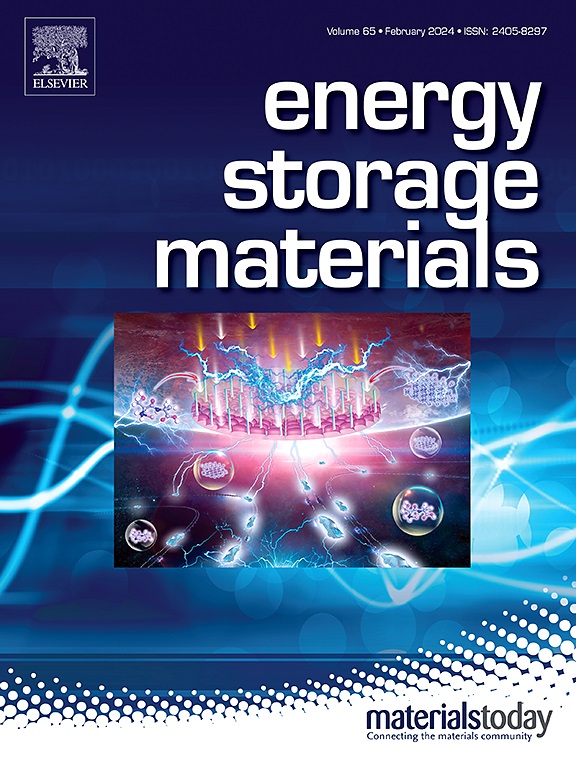Regulating Na/Fe Antisite Defects and Suppressing Elemental Segregation Toward a Phase-Pure Na4Fe2.91(PO4)2(P2O7) Cathode with Fast Intercalation Kinetics
IF 18.9
1区 材料科学
Q1 CHEMISTRY, PHYSICAL
引用次数: 0
Abstract
Na4Fe2.91(PO4)2(P2O7) (NFPP) is an attractive cathode material for commercial sodium-ion batteries. However, local phosphorus aggregation and Na/Fe antisite defects lead to the formation of a low-capacity Na2FeP2O7 (N2FP) impurity and slow Na+ diffusion, which diminish its electrochemical performance. To address these challenges, we introduce a dual-site tungsten (W) doping strategy. The doping of W6+ at the Fe site suppresses Na/Fe antisite defects, redistributes electrons around Fe atoms, and creates Na vacancies through a charge compensation mechanism. This process reduces the band gap (from 2.82 to 0 eV) and lowers the Na+ migration energy barriers (from 3.30 to 1.76 eV). Furthermore, W forms [WO4] polyanion groups that partially replace [PO4], reducing local phosphorus concentration and the formation energy of NFPP phase, thereby limiting the generation of N2FP impurity. Notably, decreased Na/Fe antisite defect levels prevent unfavorable structural rearrangements during early cycles, reducing capacity decay in the first 40 cycles from 1.8% to 0%. As a result, W-doped NFPP exhibits a high discharge specific capacity (113.8 mAh g-1 at 0.1C between 2-4 V), long cycle life (stable for 2000 cycles at 20C), and excellent temperature stability (from -20°C to 50°C). This study provides a novel approach for designing high-performance NASICON-type cathode materials and advances the commercialization of sodium-ion batteries.调控Na/Fe反位缺陷和抑制元素偏析制备具有快速插层动力学的相纯Na4Fe2.91(PO4)2(P2O7)阴极
Na4Fe2.91(PO4)2(P2O7) (NFPP)是一种极具吸引力的商用钠离子电池正极材料。然而,磷的局部聚集和Na/Fe对位缺陷导致了低容量Na2FeP2O7 (N2FP)杂质的形成和Na+的缓慢扩散,降低了其电化学性能。为了解决这些挑战,我们引入了一种双位点钨掺杂策略。W6+在Fe位的掺杂抑制了Na/Fe对位缺陷,使电子在Fe原子周围重新分布,并通过电荷补偿机制产生Na空位。该过程减小了带隙(从2.82 eV降至0 eV),降低了Na+迁移能垒(从3.30 eV降至1.76 eV)。W形成[WO4]多阴离子基团,部分取代[PO4],降低了局部磷浓度和NFPP相的形成能,从而限制了N2FP杂质的生成。值得注意的是,降低的Na/Fe对位缺陷水平防止了早期循环中不利的结构重排,将前40个循环中的容量衰减从1.8%降低到0%。因此,w掺杂的NFPP具有高的放电比容量(113.8 mAh g-1, 0.1C, 2-4 V),长循环寿命(在20C下稳定2000次)和优异的温度稳定性(从-20°C到50°C)。该研究为高性能nasicon型正极材料的设计提供了新的途径,并推动了钠离子电池的商业化。
本文章由计算机程序翻译,如有差异,请以英文原文为准。
求助全文
约1分钟内获得全文
求助全文
来源期刊

Energy Storage Materials
Materials Science-General Materials Science
CiteScore
33.00
自引率
5.90%
发文量
652
审稿时长
27 days
期刊介绍:
Energy Storage Materials is a global interdisciplinary journal dedicated to sharing scientific and technological advancements in materials and devices for advanced energy storage and related energy conversion, such as in metal-O2 batteries. The journal features comprehensive research articles, including full papers and short communications, as well as authoritative feature articles and reviews by leading experts in the field.
Energy Storage Materials covers a wide range of topics, including the synthesis, fabrication, structure, properties, performance, and technological applications of energy storage materials. Additionally, the journal explores strategies, policies, and developments in the field of energy storage materials and devices for sustainable energy.
Published papers are selected based on their scientific and technological significance, their ability to provide valuable new knowledge, and their relevance to the international research community.
 求助内容:
求助内容: 应助结果提醒方式:
应助结果提醒方式:


